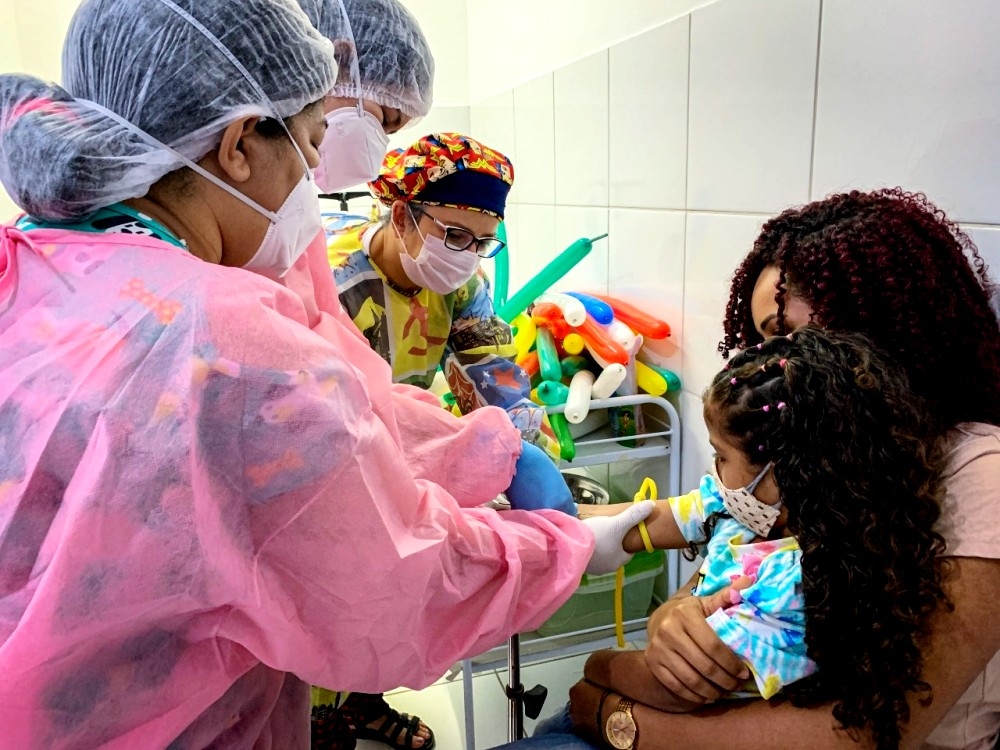


In a longitudinal survey of children born in 2015 and 2016 in a city in Acre State, North Brazil, over half of the participants reported experiencing hunger in the previous month. The occurrence of symptoms also correlated with social vulnerability, and with the mother’s schooling and skin color (photo: Bárbara Prado).
Published on 08/01/2022
André Julião | Agência FAPESP – Food insecurity contributes significantly to the incidence of COVID-19 among children, according to an article by Brazilian scientists published in PLOS Neglected Tropical Diseases.
The research reported in the article was part of the project “Maternal and child health in Acre: birth cohort in the western Brazilian Amazon (MINA Brazil)”, in progress with FAPESP’s support since 2015 in Cruzeiro do Sul, a medium-sized city in Acre, a state in Brazil’s North region (more at: https://agencia.fapesp.br/37047/ and https://agencia.fapesp.br/38866/).
“Among children with serological evidence of prior infection by SARS-CoV-2, those whose households experienced hunger in the month before the interviews were 76% more likely to have COVID-19 than children who hadn’t been exposed to food insecurity,” said Marly Augusto Cardoso, a professor at the University of São Paulo’s School of Public Health (FSP-USP) and principal investigator for the study.
On two occasions, first in January and then in June-July 2021, tests were performed to detect antibodies against SARS-CoV-2 in 660 of the 1,246 children born in 2015 or 2016 and initially followed for the study, as well as interviews with mothers or carers.
The researchers asked about COVID-19 symptoms such as coughing, breathlessness, and loss of taste and smell. A questionnaire also sought evidence of food insecurity in the household to see if a child’s family had been on the verge of starvation in the previous month.
“Adults normally prioritize feeding children. They're capable of going hungry themselves to give their children a meal. If a child in the household is hungry, it’s a sign that conditions are very tough for the whole family,” Cardoso said.
Over half the participants (54%) lived in households with food insecurity. Among these, 9.3% reported symptoms of COVID-19, compared with 4.9% of the children whose families did not face food insecurity, showing 76% higher vulnerability to clinical manifestations of the disease in this group. The higher incidence also correlated with poor housing conditions, lower levels of schooling, and the non-white skin color of the mother.
Antibodies against SARS-CoV-2 were detected in 297 children (45%). Only 11 (3.7%) had been tested to confirm the diagnosis of COVID-19 before the study, and 48 (16.2%) had symptoms such as cough, lack of breath, and loss of taste and/or smell. The poorest had more symptoms.
Underreporting
“Studies are showing that socio-economic status and nutrition influence a higher occurrence of infectious diseases. We don’t have enough data yet to say this about COVID-19, but our study and research conducted in other countries provide evidence that this correlation exists,” Cardoso said.
She and her group are now analyzing gut microbiota samples from participants in the study, in search of correlations between diet and the occurrence of diseases, including COVID-19.
Although antibodies against SARS-CoV-2 were detected in almost half the children, only 5% of the mothers reported a prior episode of COVID-19 in their children, suggesting that eight out of nine infections went undiagnosed and unreported.
Underreporting has public health consequences, according to the researchers, such as the false perception that children are less susceptible to the disease. In other contexts, for example, less frequent occurrence of clinically diagnosed COVID-19 in children was considered justification for parents to delay or refuse vaccination for their children of vaccine-eligible age.
The fact that many children are asymptomatic, however, means they can transmit the virus to the rest of the household, including individuals who are susceptible to more severe forms of the disease, such as the elderly and people with co-morbidities.
In the study just published, most of the infected children had relatives with COVID-19, especially their mothers. Those whose mothers were not infected, had fathers, siblings, grandparents or neighbors with symptoms of the disease. Clinical manifestations were more frequent in subjects exposed to food insecurity or with a non-white mother.
The limitations of the study included the fact that the participants in this segment of MINA Brazil focusing on SARS-CoV-2 lived in the urban area or accessible rural areas. The researchers believe the situation may be worse in remote areas without local health services.
“In remote areas, it’s hard to keep doing follow-up, and we lost contact with many of these participants,” Cardoso said. “The same applies to the poorest people. It can be hard to locate them because they move house a lot. Some migrate to a different part of the country. We lost contact with over 300 children in five years of the study.”
Another significant finding was that fewer children of mothers with more than 12 years of schooling had symptoms of the disease. The manifestation of symptoms increased as the number of years of formal maternal education fell.
“It’s important to note that children in poor households and children with less educated mothers were significantly more likely to be seropositive for SARS-CoV-2. This reflects their worse socio-economic conditions than those with more schooling, as well as less access to information and alternative sources of income, all of which in turn means less healthcare for their children,” Cardoso said.
“The studies we’ve done on malaria, child development, and nutrition had similar findings. Investing in maternal education also has an impact on the children’s quality of life.”
The article “SARS-CoV-2 seropositivity and COVID-19 among 5-year-old Amazonian children and their association with poverty and food insecurity” is at: https://doi.org/10.1371/journal.pntd.0010580.
Source: https://agencia.fapesp.br/39249